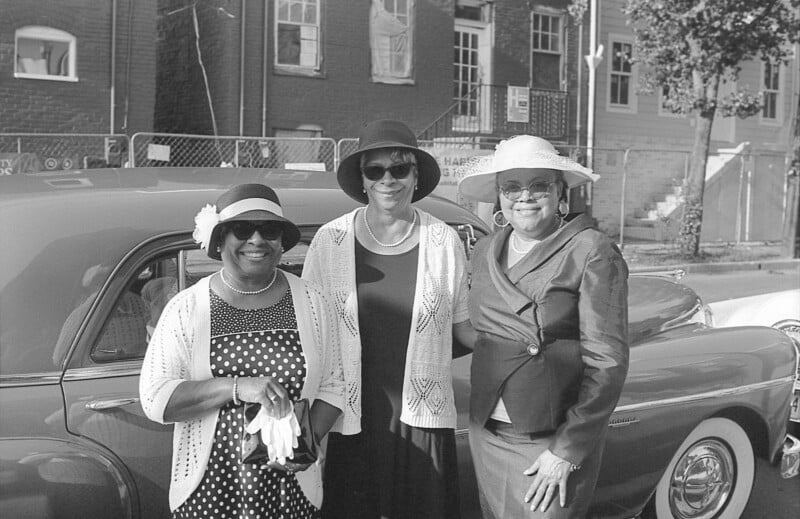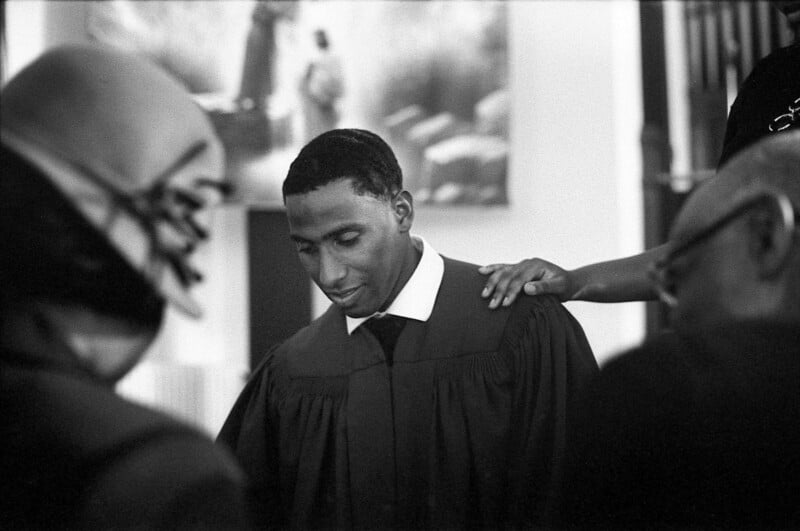I Was Cast as a Photographer in a Historical Movie About a Maryland Town

Boomtown is a local independent movie by Big Picture Media. It chronicles key moments in the history of downtown Frederick, Maryland through the lens of the Frederick News Post and their first African American chief photographer, Amos Brown.
It turned out that the role was for a 1960s press photographer named J. Rolfe Castleman. And McLaughlin didn’t want someone to just pretend to use an old camera as is common in historical movies, he wanted a photographer to take real photos of scenes in the movie with a period-correct camera on film.
Being a working photographer who covers events exclusively on 35mm, I not only felt that I was the perfect choice, but I must admit that I was pretty excited about the role and the authenticity of the director’s approach.
Excerpt from the script:
April 7, 1968 Asbury Methodist Church [3 days after the assassination of Martin Luther King Jr.]
Amos Brown is 18 years old and singing in the choir that morning…. Words spoken by Reverend McDonald and civil rights leader Sherman Mason are featured. The gospel choir sings “Precious Lord Take My Hand.” … There’s also a [Frederick News Post] reporter (George Dorsey) and a photographer in attendance.
In the scene, the reporter approaches Amos Brown to tell him that he’s been accepted to join the Frederick News Post. This pivotal moment, set against the backdrop of the civil rights movement, marks the start of Amos’ journey to become the paper’s chief photographer and to make his impact on the community.
Meanwhile, playing an existing FNP photographer, I documented the scene and my photos will be featured in other parts of the movie.
For my character, I used two Nikkormat FTn SLR cameras with 28mm, 50mm, and 135mm lenses. The Nikkormat FTn was released in 1967 and was an affordable alternative to the monumental Nikon F. It makes sense that a local press photographer would be using a capable but economical outfit like this in April of 1968. And on a practical level, it’s still common today, almost sixty years later, to see fully functional Nikkormats – making them ideal candidates for projects like this.

My scenes were both outside and inside Asbury Church on a sunny morning.
For the exteriors, I shot Kodak TMAX 100 whose tabular grain was not around in the 1960’s. But it’s a very tonal film with nuanced greys that I think can match the aesthetic of a lot of mid-century news photography.


The interior of the church was brightly lit but soft with a hint of artificial fog for atmosphere.
I wanted to use Kodak Tri-X 400 inside the church since this film has been around since 1954. It would have been a realistic film choice for my character. But I usually expose for shadows with Tri-X to increase contrast. Because I wanted my photos of the MLK service to be more tonal like TMAX, not only did I expose for just above middle grey, when I processed the Tri-X, I didn’t agitate the film as much as I normally do to bring out more tonality.





For both the TMAX and Tri-X, when scanning and editing, I kept my histograms narrower than normal for flatter images with greyer shadows. Finally, I allowed slightly more dust than usual to stay on the final images, and in some cases, I noticeably dodged the subject as you tend to see with hastily printed, mid-century darkroom images.
Vintage cameras bring an authentic energy from the scenes that they’ve bore witness to in the past – at least if you know about what they’ve seen! It’s impossible to know if these Nikkormats that I purchased used many years ago had any part in conveying the actual civil rights movement of the 1960s, but in 2020 I used these same cameras to cover a Black Lives Matter protest and my account was picked up by Film Photograph Project. I like to think this experience contributed in some way to my role in Boomtown.
Entranced by the soulful singing of the Asbury Church choir, I wound film through my cameras and considered the ties between all of these events and the meaning of this moment in Boomtown the movie, and in history.
For Boomtown’s next shoot in early December, the negatives from these photos will appear in another scene where they are “developed” and then printed on camera, to appear in the movie itself.
Learn more about Boomtown, the story of downtown Frederick, Maryland at www.BoomtownFrederick.com.
About the author: Johnny Martyr is an East Coast film photographer. The opinions expressed in this article are solely those of the author. After an adventurous 20-year photographic journey, he now shoots exclusively on B&W 35mm film that he painstakingly hand-processes and digitizes. Choosing to work with only a select few clients per annum, Martyr’s uncommonly personalized process ensures unsurpassed quality as well as stylish, natural & timeless imagery that will endure for decades. You can find more of his work on his website, Flickr, Facebook, and Instagram.



